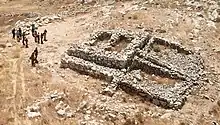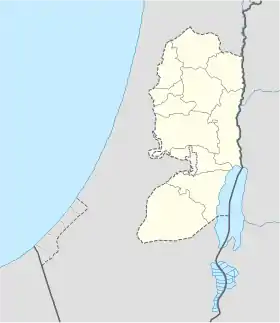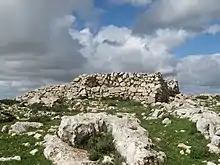Mount Ebal site
The Iron Age I Structure on Mt. Ebal,[1][2] also known as the Mount Ebal site,[3] Mount Ebal's Altar, Joshua's Altar[4][5] and Northern el-Burnat, is an archeological site on Mount Ebal, West Bank.[1] The site, dating from the Iron Age I, is located a few kilometers east of Asira ash-Shamaliya, northeast of Nablus and north of Tell Balata (biblical Shechem).
 Aerial photo | |
 Shown within the West Bank | |
| Location | West Bank |
|---|---|
| Coordinates | 32.23946°N 35.287396°E |
| Type | cultic site |
| History | |
| Periods | Early Iron Age |
| Cultures | Israelite |
| Site notes | |
| Discovered | 1980 |
| Excavation dates | 1982-1989 |
| Archaeologists | Adam Zertal; University of Haifa and the Israel Exploration Society |
| Condition | In ruins |
| Public access | Limited |
The Mount Ebal site was discovered by Israeli archaeologist Adam Zertal during the survey of Manasseh in 1980, who later carried out excavations at the site throughout the 1980s.[1] Zertal believed that the site should be identified as Joshua's Altar mentioned in the Hebrew Bible, and other alternatives were also proposed.[5][1] Today, many archeologists agree that the structure was a site of an early Israelite cultic activity, however, its identification with Joshua's altar is disputed.[6][7][8]
In 2021, a portion of the site was damaged by the Palestinian National Authority.[9]
Discovery, Excavations and Findings
Like many other sites in the region, by the 20th century there was a large stone heap found on Mount Ebal; this one was known to locals as el Burnat (Arabic for the Hat). The Mount Ebal structure was found by Adam Zertal in 1980,[3][10] within a naturally shaped amphitheatre.[11] Excavations, conducted by the University of Haifa and the Israel Exploration Society, lasted eight seasons between 1982 and 1989.[3]
Upon archaeological investigation, several potsherds were found among this heap, and were dated to 1220–1000 BC, a date for which no other remains are found nearby,[11] and so a more substantial archaeological excavation was launched at the site in 1987.[11] The excavation found a large walled structure, seemingly built direct into the bedrock without a doorway or floor, and had been infilled by layers of stone, ash, and earth;[11] on the southwest were found two paved areas split apart by a further wide wall higher at one end than the other and with a surrounding oval wall.[11] Slowly burnt bones were found at the site, and after analysis were discovered to originate from bullocks, goats, and fallow deer.[11]
Interpretation
The excavating archaeologist, Adam Zertal, believed that the site was the compound containing the biblical altar built by Joshua.[5][11] According to the Book of Joshua, the Israelites under the leadership of Joshua had built an altar on Mount Ebal, as had instructed earlier by Moses.[12][13] During the ceremony that followed, Joshua renewed the covenant between Yahweh and the Israelites enacted on Mount Sinai.[1]
The filled walled structure being the altar itself – the filling being a part of the altar rather than debris (and indicative of an Assyrian style altar,[11] like that specified in the Book of Exodus as being hollow with boards[14]) – and the wall between the two courtyards being a ramp (in accordance with the no steps instruction in Exodus[15]), most other archaeologists believe it to be something else.[11]
The site has a significant issue in regard to the Biblical account of Joshua's altar, as it is located on the north side of the mountain, and not the south side facing Mount Gerizim, making a curse & blessing ritual held there and on Gerizim somewhat difficult to hold antiphonally;[11] the excavating archaeologist proposed that this could be resolved by identifying a mountain to the north as Gerizim rather than the usual location, though the suggestion was rejected by both the Samaritans, who found it offensive to move the center of their religion, and by other scholars and archaeologists.
Though some archaeologists agree with the consideration that the site was an altar compound (though not necessarily constructed by Joshua), and some (including Israel Finkelstein) at least agree that it was a cultic location (though not necessarily involving an altar), others believe that it was simply a farmhouse, a guard tower[16] or the Biblical tower of Shechem.[11] Those considering it to be a farmhouse and/or the tower of Shechem, argue that the paved areas are simply rooms, the sloping wall simply an eroded partition wall, and the infilled enclosure a room that was later changed into a tower – the foundation of the tower being the infill, and the rest of the tower now destroyed.[11]

Access
Israelis wishing to visit the site today must coordinate their activity with COGAT, the Israeli Defense Ministry unit which manages civilian affairs for Palestinians in the West Bank and liaises with Gaza, since Mount Ebal is located in what is now designated as Area B. In addition, Israeli citizens visiting the area are required to be escorted by IDF soldiers, to ensure their personal safety. The Shomron Regional Council, as of July 2016, was trying to promote the area as a tourist destination.[17]
Damage
In February 2021 a portion of the site was destroyed by the Palestinian Authority and the stones were ground up and used to pave a nearby road.[9]
See also
References
- "The Iron Age I Structure on Mt. Ebal: Excavation and Interpretation By Ralph K. Hawkins". www.eisenbrauns.org. Retrieved 2022-04-30.
- "Discovery and Excavation of the Ebal Structure", The Iron Age I Structure on Mt. Ebal, Penn State University Press, pp. 4–29, 2012-06-22, retrieved 2022-04-30
- "The Iron Age I Structure on Mt. Ebal: Excavation and Interpretation By Ralph K. Hawkins". www.eisenbrauns.org. Retrieved 2022-04-30.
- "Joshua's altar: the dig at Mount Ebal". Choice Reviews Online. 29 (05): 29–2792-29-2792. 1992-01-01. doi:10.5860/choice.29-2792. ISSN 0009-4978.
- Zertal, A. (1985). Has Joshua's altar been found on Mt. Ebal?. Biblical Archaeology Society.
- "The Iron Age I Structure on Mt. Ebal: Excavation and Interpretation By Ralph K. Hawkins". www.eisenbrauns.org. Retrieved 2022-04-30.
- Antti Laato (2014). "The Cult Site on Mount Ebal: A Biblical Tradition Rewritten and Reinterpreted .". In Koskenniemi, Erkki; Vos, Jacobus Cornelis de (eds.). Holy Places and Cult. Pennsylvania State University Press. p. 55. ISBN 978-952-12-3046-2. Retrieved 30 April 2022.
- Ulrich, Eugene (14 April 2015). The Dead Sea Scrolls and the Developmental Composition of the Bible. BRILL. p. 61. ISBN 978-90-04-29603-9. Retrieved 30 April 2022.
- Lazaroff, Tovah (10 February 2021). "'Prophet Joshua's Mount Ebal altar site harmed by Palestinian road work'". JPost. Retrieved 11 February 2021.
- "Archived copy". Archived from the original on 2009-06-29. Retrieved 2009-07-09.
{{cite web}}: CS1 maint: archived copy as title (link) - Matthew Sturgis, It Ain't Necessarily So, ISBN 0-7472-4510-X
- Joshua 8:30–35
- Deuteronomy 27:1–8
- Exodus 27
- Exodus 26
- Assaf Kamar, 'A rare visit to the supposed altar of prophet Joshua,' Ynet 9 August 2016.
- Kamar, Asaf (22 July 2016). "A rare tour of "the altar of Joshua" on the Mountain of the Curse". Ynet. Retrieved 29 July 2016.
| Wikimedia Commons has media related to Joshua's Altar on Mount Ebal. |